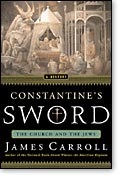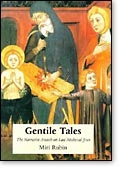Lauren F. Winner
Killing Jesus All Over Again
How medieval stories about desecrating the Eucharist were used to justify the murder of Jews.This is the third installment in a five-part series.
Part 1 [November/December 2000], "Living by Law, Looking for Intimacy," explored what Christians can learn from the debates that divide American Jews, taking as a point of departure Samuel G. Freedman's book, Jew vs. Jew: The Struggle for the Soul of American Jewry.
Part 2 [January/February 2001], "God of Abraham—and Saint Paul," focused on the pathbreaking "Jewish Statement on Christians and Christianity" published last fall in the New York Times and the book of essays it occasioned, Christianity in Jewish Terms, edited by Tikva Frymer-Kensky, David Novak, Peter Ochs, David Fox Sandmel, and Michael A. Signer.
Next, part 4 will discuss German Jews, Edith Stein in particular.
Part 5 concludes the series with Messianic Judiaism.

Constantine's Sword
Constantine's Sword: The Church and the Jews: A History, by James Carroll, Houghton Mifflin, 576 pp.; $28

Gentile Tales
Gentile Tales: The Narrative Assault on Late Medieval Jews, by Miri Rubin, Yale University Press, 266 pp.; $35
What would it mean for Christians to rethink their history with respect to the Jews? James Carroll—former Catholic priest and author of many books, both fiction and nonfiction—has one answer. In his new book, Constantine's Sword, he surveys the centuries since Christ and concludes that Christianity's rejection of the Jews was a fatal flaw at the very beginning of the long history of the church. "Almost every single tenet of Christianity, every single orthodoxy about Jesus, is wrong, says Carroll," an admiring reviewer reports.[1] In Carroll's own words, what we learn from history is that Christians must fashion a new theology "without Golgotha, redemption, or sacrifice," a Christianity which has divested itself of the claim that salvation comes through Christ.
Christians are unlikely to be persuaded, unless they have already all but checked out of the faith. How easy it would be, then, given Carroll's agenda, for believers to reassure themselves that they need not bother with the history that is Carroll's ostensible subject. Yes, yes, anti-Semitism is a terrible thing, and the Nazis were unspeakably evil, but we're enlightened now. How easy to settle for such complacent pieties, instead of trying to reckon with a history that is deeply troubling and twisted, endlessly tangled. (On this, if nothing else, Carroll is persuasive.)
But for Christians who agree with Carroll that "the story could have gone in a way more consonant with the message of Jesus," while yet hoping, contra Carroll, to learn from the past without giving up their faith in the process, there are many places to start. One of the best is Miri Rubin's Gentile Tales: The Narrative Assault on Late Medieval Jews, published two years ago by Yale University Press, a haunting, provocative, beautiful book. (Yale is to be commended for the thick, glossy paper and the striking color plates.) The prose is, at times, lyrical and poetic. The story is, always, disturbing.
The story is one about stories, stories about medieval Jews stealing Eucharistic wafers and desecrating them—puncturing them, piercing them, battering them. The hosts survive, bleeding sometimes, often changing into crucifixes or performing some other miracle. The Jews don't survive, not as Jews anyway: they either convert, awestruck, or are killed, obstinate.
The first fully documented host desecration narrative is found at the end of the thirteenth century, but the pieces of that story, Rubin shows, had circulated long before. In 1205 Innocent III requested church leaders in Sens and Paris to prevent Jews from hiring Christian wet-nurses, a telling move, since in the later host desecration narratives, it was often a Christian servant who procured the host for Jewish employers. The Fourth Lateran Council (1215) made no explicit connection between Jews and the Eucharist, but it did both limit contact between Jews and Christians and lay down transubstantiation as an article of faith.
A popular Marian tale, which adumbrated the later host desecration stories, had circulated since at least the sixth century. The tale opens with a Jewish boy receiving the Eucharist. When his father learns that his son has partaken, he flies into a rage and, Nebuchadnezzar-like, throws the son into an oven. Mary swoops into the oven to shield the boy from the oven's flames. This Marian miracle converts the son and his mother to Christianity, and angry Christians push the stiff-necked father into the oven to burn.
We find "the first complete telling of the accusation story" in Paris in 1290 (though, Rubin is quick to point out, that telling "could have occurred in any number of German towns, and indeed soon did"). A Jew coerced a poor Christian woman— either a debtor or a servant—into bringing him Easter communion. Desiring to know "whether the insane things which Christians prattle about this are true," the Jew set about hacking the host with a knife. The host, of course, stayed in one piece, bleeding. The Jew drove nails through the host, tried to burn it, and tossed it into a pot of boiling water. The host withstood the nails and fire, and its blood turned the water red. The host then morphed into a crucifix that floated above the pot. The Jewish mother and children were moved by the Eucharistic miracles, but the Jewish man remained obdurate. Ultimately, the wife and children converted, the man was burned, his house was confiscated and sold, and a chapel was built in its place.
After Paris, the host desecration narrative spread throughout Europe. Violence was the host desecration narrative's companion. One example, drawn from late fourteenth-century Brussels, will suffice. A number of Jews lived in Brabant. An accusation of host desecration was made against Jonathan of Enghein, a wealthy Jewish financier. According to the tale that was told, Jonathan asked a Jewish convert, John of Louvain, to procure hosts from a nearby chapel. The convert did so, delivering sixteen Eucharistic wafers. Jonathan and some other Jews took the wafers to the synagogue and pierced them with knives. Two weeks later, after a band of men killed Jonathan as he strolled in his garden, Jonathan's wife decided to get rid of the wafers. She asked another convert, Katherine, to take the hosts to Cologne. Katherine agreed, but instead delivered them to the local priest. Eventually, the Duke and Duchess of Brabant learned of the happenings. They interrogated Katherine and ordered that all the Jews from Brussels and Louvain should be put in prison. On Ascension Day, the Jews were marched through the streets of Brussels and executed in front of the chapel from which John of Louvain had stolen the hosts.
The host desecration narrative made possible the torture of Jews, for it made Jews culpable. It transformed Christian torture of Jews from an outlandish lashing out against a powerless people to a reasonable response to the seemingly powerful Jews who steal the host and try to destroy it—an act that, of course, echoes Jews' destroying the body of Christ in the deicide.
The holocaust casts a long shadow over the historiography of medieval Jewry, with scholars being quick to read the Middle Ages through Holocaust lenses. Too many historians have been interested in medieval Judaism only insofar as it sheds light on Auschwitz, concluding, like Norman Cohn in Warrant for Genocide, that at the heart of Shoah "lies the belief that the Jews—all Jews everywhere—form a conspiratorial body set on ruining and then dominating the rest of mankind. And this belief is simply a modernized, secularized version of the popular medieval view."
The extent to which the Shoah should influence studies of pre-twentieth-century Europe is, a matter of some debate among scholars. Folks like Michael Bernstein (author of Foregone Conclusions: Against Apocalyptic History) suggest that one must guard against teleological readings of the past in order to emphasize historical contingency—and, in the case of the Holocaust, to avoid condemning those Jews who did not leave Europe because they did not see the inevitable coming. At the other extreme is someone like Stephen Zipperstein, who, in Imagining Russian Jewry, takes Bernstein to task for naivete. Historians can hardly pretend they don't know that the Holocaust happened, Zipperstein says. You can't completely suspend your knowledge of the Shoah.
Rubin skillfully navigates between a teleological overreading and an underreading in which the Holocaust is invisible. Gentile Tales does not take as its task the explanation of the death camps. Rubin does not posit some seamless, transhistorical anti-Jewish sentiment that was born in the late Middle Ages and culminated in the Holocaust. She is interested not in offering a genealogy of a hatred that led to the Holocaust, but in understanding the exclusion of and violence against medieval Jews on its own terms.
Still, Rubin does not deny that the Holocaust lurks around the fringes of any study of medieval violence against Jews. The scholar writing about the creation and deployment of host desecration tales, Rubin admits in her introduction, faces more than the source problems that routinely bedevil medieval historians. There is also "the compelling feeling of personal involvement when touching headstones or reading texts in Hebrew." There is the rush of emotions when visiting chapels that had been built where a synagogue once stood, a synagogue razed in the wake of a host desecration accusation. There is the temptation to lapse into "pat generalisations about Christianity, about human nature, about Germans." And there are also the inspiring examples of the few medieval people who doubted and challenged the ubiquitous host desecration stories. "There is clearly history after Auschwitz," she writes, "and poetry too—we cannot do without them."
All societies, Rubin says, have the capacity for exclusion and violence, and if there is a "historical lesson" to be learned from the medieval host desecration narrative, it is that one must pay careful attention to "violent intolerant language," for once such language "is about, increasingly heard, spoken with impunity, then violent action is almost sure to follow." We must pay attention "at the inception of narratives of exclusion, not only at their end." And we must realize that "the licence for violence is not necessarily encoded in secret or sectarian codes, it is penned at the heart of cultures, with an ink coloured by their most familiar symbols."
For Christians, this last lesson is particularly important. The Eucharist, as Rubin showed in her earlier book, Corpus Christi, very much lay at the heart of medieval culture—and of course at the heart of Christianity itself. In the host desecration narrative, this supreme expression of sacrifical love was perverted to become a warrant for brutality and even for murder.
Gentile Tales ought not be relegated to medievalists' shelves. It belongs in the library of every Christian (and, for that matter, every Jew) who is concerned about Christians and Jews, and what the former have done to the latter in the name of the God we share.
Lauren Winner, a contributing editor for Books & Culture, is a doctoral candidate in the history of American religion at Columbia University.
1. Zachary Karabell, Chicago Tribune, February 4, 2001.
NOTE: For your convenience, the following book, which was mentioned above, is available for purchase:
• Constantine's Sword, by James Carroll
• Gentile Tales, by Miri Rubin
Copyright © 2001 by the author or Christianity Today/Books & Culture Magazine.
Click here for reprint information on Books & Culture.








Displaying 0–0 of 0 comments.
Displaying 0–0 of 0 comments.
*